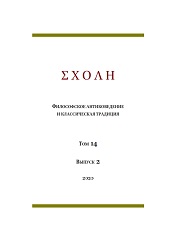Рыбы, живущие в земле Аристотель. О дыхании 9, 475b 10-11
Fishes that live in the earth. Aristotle. On respiration 9, 475b 10-11
Author(s): Svetlana MesyatsSubject(s): Ancient Philosphy, Philosophy of Science, Ontology
Published by: Новосибирский государственный университет
Keywords: ancient philosophy; Aristotle; Theophrastus; Parva naturalia; Aristotle’s psychology; theory of respiration; cooling; fish; bloodless aquatic animals;
Summary/Abstract: Many translators and commentators of Aristotle's treatise On respiration are puzzled by his statement at De resp. 9, 475b 10-11 that “most fishes live in the earth … and are found by digging” (τῶν ἰχθύων οἱ πολλοὶ ζῶσιν ἐν τῇ γῇ). Indeed, this phrase seems to contradict not only common sense, but also Aristotle’s own words in the History of animals and other biological treatises, that aquatic animals, like fishes who take in water for cooling, cannot survive for a long time outside their native element. The paper shows that the replacement of the expression “most fishes” (οἱ πολλοὶ) by “many fishes” (πολλοὶ) proposed by W. Ogle and D. Ross does not solve the problem, since the few rare species of the land fish reported by Theophrastus in the treatise On creatures that live on dry land can hardly be called “many fishes”. In my opinion, the reason why the Aristotelian text is so puzzling is a misunderstanding of the expression ἐν τῇ γῇ. Although Ogle and Ross believe this to mean "on dry land", Aristotle may have in mind the mud and sand on the seabed. According to the philosopher, most fish do periodically bury themselves in mud at the bottom of the sea or rivers, thus maintaining the balance of heat and cold necessary for their life. Therefore, I affirm that the text of Aristotle does not need to be corrected.
Journal: ΣΧΟΛΗ. Философское антиковедение и классическая традиция
- Issue Year: XIV/2020
- Issue No: 2
- Page Range: 483-498
- Page Count: 16
- Language: Russian

